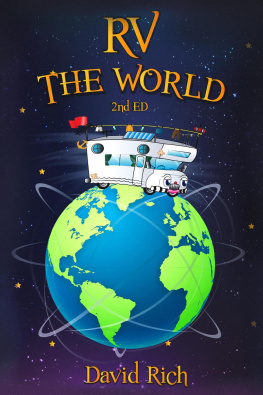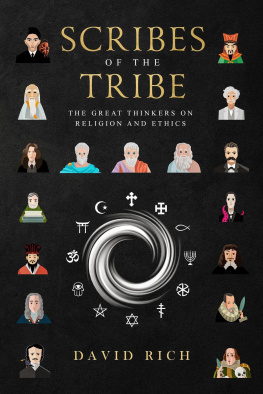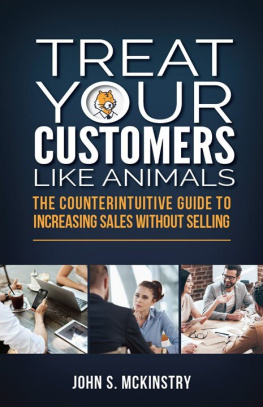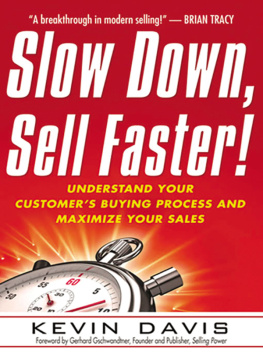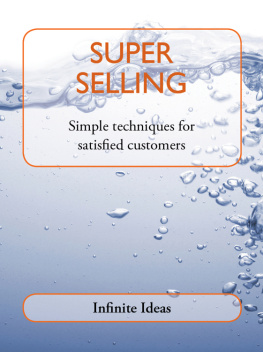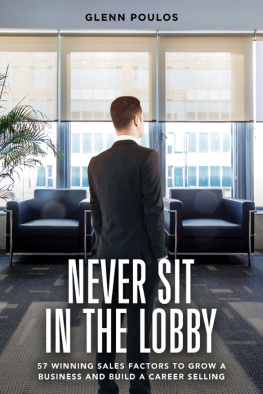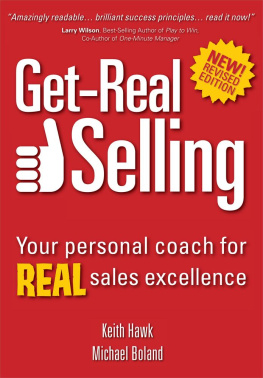
Contagious Selling
HOW TO TURN A
CONNECTION INTO A
RELATIONSHIP THAT
LASTS A LIFETIME
DAVID A. RICH


Copyright 2013 by the McGraw-Hill Companies, Inc. All rights reserved. Printed in the United States of America. Except as permitted under the United States Copyright Act of 1976, no part of this publication may be reproduced or distributed in any form or by any means, or stored in a database or retrieval system, without the prior written permission of the publisher.
e-ISBN: 978-0-07-179696-5
e-MHID: 0-07-179696-7
All trademarks are trademarks of their respective owners. Rather than put a trademark symbol after every occurrence of a trademarked name, we use names in an editorial fashion only, and to the benefit of the trademark owner, with no intention of infringement of the trademark. Where such designations appear in this book, they have been printed with initial caps.
McGraw-Hill eBooks are available at special quantity discounts to use as premiums and sales promotions, or for use in corporate training programs. To contact a representative please e-mail us at bulksales@mcgraw-hill.com.
TERMS OF USE
This is a copyrighted work and The McGraw-Hill Companies, Inc. (McGraw-Hill) and its licensors reserve all rights in and to the work. Use of this work is subject to these terms. Except as permitted under the Copyright Act of 1976 and the right tostore and retrieve one copy of the work, you may not decompile, disassemble, reverse engineer, reproduce, modify, create derivative works based upon, transmit, distribute, disseminate, sell, publish or sublicense the work or any part of it without McGraw-Hills prior consent. You may use the work for your own noncommercial and personal use; any other use of the work is strictly prohibited. Your right to use the work may be terminated if you fail to comply with these terms.
Library of Congress Cataloging-in-Publication Data
Rich, David A.
Contagious selling : how to turn a connection into a relationship that lasts a lifetime / by David Rich.
p. cm.
ISBN 978-0-07-179695-8 (alk. paper)ISBN 0-07-179695-9 (alk. paper) 1. Selling. 2. Customer relations. I. Title.
HF5438.25.R5123 2013
658.85dc23
2012030631
I dedicated this book to the hundreds of people I have met through the years who have taught me a little something about selling and building relationships.
Contents
M y mother-in-law cant stand the fact that her daughter married a salesman. For over 25 years, Ive endured her lamentations on the obnoxiousness of salespeople. She says she can spot a salesperson from a mile away. She says theyre arrogant, pushy, self-serving, manipulative, transparent, and fake. She doesnt like it when they make their pitch, and she despises it when they try to close. It feels like high pressure to her. I think shed rather run through the streets naked than deal with a salesperson. Her animosity runs that deep. You know what? For the most part, shes right.
I know youre thinking that Im generalizing and condemning an entire profession because of a few bad apples. I concede the point, but too many salespeople (and more and more each day) fit my mother-in-laws preconception. It only takes a few bad apples to create a negative overall impression. Take lawyers, for example. Most lawyers are reputable and honest, but a few have been known to stretch the ethical boundaries, and thats all it took to make the general public wary and skeptical.
I may be hypersensitive to the plight of salespeople not only because I am one but also because Ive been teaching selling skills for a quarter of a century. At best estimate, Ive trained over a half million salespeople in my career. I dont mention this to brag as much as to set up my next point. The world has changed, and selling is a lot harder today than its ever been. Things that worked in the past dont work today. Skills that closed the sale 30 years ago now turn customers off. Customers spot insincerity in seconds, and building relationships with them is harder than ever.
There are lots of reasons for this. For one, technology has made it harder to connect with people. Business has become a fax, a message on someones voice mail, or an e-mail. Face-to-face meetings have become rarer with each passing year. For as much as I know better, I find myself guilty of this almost daily. I catch myself hoping to get someones voice mail so I can quickly and effortlessly leave a message. I call this shotgun rapport : in and out and on to the next call. Technology may have made things speedier and easier, but its damaging to creating and maintaining rapport and loyalty.
Another reason selling is harder is in the nature of todays economy: businesses are meaner and leaner, and they are minding the pennies closer than ever before.
Another is increased competition. When I was a kid growing up in Allentown, Pennsylvania, every male between the ages of 5 and 85 went to the same barber in town. I can remember my grandfather taking me to get my haircut from good old Blind Charlie. Bear in mind that Charlie really wasnt blind. He earned the nickname because you couldnt get a haircut (and shave, for the older guys) without coming out bleeding. There was a joke among us kids that we could tell when someone got a haircut because we could see the scabs on the back of his neck! We didnt care. It was part of the haircut, and Charlie always gave us a bag of goodies at the end. We looked forward to it. But what would happen today if someone cut our kids neck during a haircut? Wed be outraged at the least, and some might even pursue legal action.
Times have changed. In those days, Charlie was the only barber in town, and we got to know him well. Today, within a 5-mile radius of my house (and I live in a much smaller town than Allentown), there are at least a dozen places to get a haircut. There are 18 banks, 6 grocery stores, 8 dry cleaners, and countless places to eat. You get the picture. Competition is greater and consumers have more choices than ever before.
The biggest reason selling is harder is because buyers are more sophisticated. They have access to more information than ever before. In many cases, buyers know more about whats being sold than the salespeople.
Ill talk about this throughout the book, but suffice it to say, selling is not what it used to be. Long gone are the stereotype door-to-door sales reps who peddled their goods out of the back of their station wagon. Selling today is synonymous with relationships. A salesperson is only as good as the quality, quantity, and speed of his or her ability to build solid relationships. This can also be said of almost every profession. A businesss success is directly proportional to the quality, quantity, and speed of its relationships. But its more than just business. The same can be said of personal success.
What my mother-in-law doesnt realize is that were all salespeople. We all have something to sell, and thats ourselves and our desires. Anyone who has ever dated another person is a salesperson. Anyone who has ever made a new friend is a salesperson. Anyone who has ever convinced another to see a particular movie or go to a certain restaurant is a salesperson. Getting married is the ultimate sale, and children are natural-born salespeople! My daughter could sell her mother and me on the idea of getting an ice cream cone just about any time she wanted one. Whether it be dating, parenting, marriage, friendships, or even casual encounters, our ability to connect to and captivate another person plays a pivotal role.
Next page

